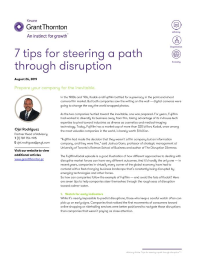-
Financial statements audits
Financial statement audits
-
Compliance audits
Compliance audits
-
Compilations and reviews
Compilations and audit
-
Agreed-upon procedures
Agreed-upon procedures
-
Corporate and business tax
Our trusted teams can prepare corporate tax files and ruling requests, support you with deferrals, accounting procedures and legitimate tax benefits.
-
International tax
Our teams have in-depth knowledge of the relationship between domestic and international tax laws.
-
Tax compliance
Business Tax
-
Individual taxes
Individual taxes
-
Estate and succession planning
Estate and succession planning
-
Global mobility services
Through our global organisation of member firms, we support both companies and individuals, providing insightful solutions to minimise the tax burden for both parties.
-
Sales and use tax and indirect taxes
SUT/ VAT & indirect taxes
-
Tax incentives program
Tax incentives program
-
Transfer Pricing Study
The laws surrounding transfer pricing are becoming ever more complex, as tax affairs of multinational companies are facing scrutiny from media, regulators and the public
-
Business consulting
Our business consulting services can help you improve your operational performance and productivity, adding value throughout your growth life cycle.
-
Forensic and investigative services
At Grant Thornton, we have a wealth of knowledge in forensic services and can support you with issues such as dispute resolution, fraud and insurance claims.
-
Fraud and investigations
The commercial landscape is changing fast. An ever more regulated environment means organizations today must adopt stringent governance and compliance processes. As business has become global, organizations need to adapt to deal with multi-jurisdictional investigations, litigation, and dispute resolution, address the threat of cyber-attack and at the same time protect the organization’s value.
-
Dispute resolutions
Our independent experts are experienced in advising on civil and criminal matters involving contract breaches, partnership disputes, auditor negligence, shareholder disputes and company valuations, disputes for corporates, the public sector and individuals. We act in all forms of dispute resolution, including litigation, arbitration, and mediation.
-
Business risk services
We can help you identify, understand and manage potential risks to safeguard your business and comply with regulatory requirements.
-
Internal audit
We work with our clients to assess their corporate level risk, identify areas of greatest risk and develop appropriate work plans and audit programs to mitigate these risks.
-
Service organization reports
As a service organization, you know how important it is to produce a report for your customers and their auditors that instills confidence and enhances their trust in your services. Grant Thornton Advisory professionals can help you determine which report(s) will satisfy your customers’ needs and provide relevant information to your customers and customers’ auditors that will be a business benefit to you.
-
Transaction advisory services
Transactions are significant events in the life of a business – a successful deal that can have a lasting impact on the future shape of the organizations involved. Because the stakes are high for both buyers and sellers, experience, determination and pragmatism are required to bring deals safely through to conclusion.
-
Mergers and acquisitions
Globalization and company growth ambitions are driving an increase in M&A activity worldwide as businesses look to establish a footprint in countries beyond their own. Even within their own regions, many businesses feel the pressure to acquire in order to establish a strategic presence in new markets, such as those being created by rapid technological innovation.
-
Valuations
We can support you throughout the transaction process – helping achieve the best possible outcome at the point of the transaction and in the longer term.
-
Recovery and reorganization
We provide a wide range of services to recovery and reorganisation professionals, companies and their stakeholders.
Prepare your company for the inevitable.
In the 1980s and ’90s, Kodak and Fujifilm battled for supremacy in the point-and-shoot camera film market. But both companies saw the writing on the wall — digital cameras were going to change the way the world snapped photos.
As the two companies hurtled toward the inevitable, one was prepared. For years, Fujifilm had worked to diversify its business away from film, taking advantage of its in-house tech expertise to pivot toward industries as diverse as cosmetics and medical-imaging technology. Today, Fujifilm has a market cap of more than $20 billion; Kodak, once among the most valuable companies in the world, is barely worth $1 billion.
“Fujifilm had made the decision that they weren’t a film company but an information company, and they were fine,” said Joshua Gans, professor of strategic management at University of Toronto’s Rotman School of Business and author of The Disruption Dilemma.
The Fujifilm-Kodak episode is a good illustration of how different approaches to dealing with disruptive market forces can have very different outcomes. And it’s hardly the only one — in recent years, companies in virtually every corner of the global economy have had to contend with a fast-changing business landscape that’s constantly being disrupted by emerging technologies and other forces.
So how can companies follow the example of Fujifilm — and avoid the fate of Kodak? Here are seven tips to help companies steer themselves through the rough seas of disruption toward calmer water.
- Watch for early indicators
While it’s nearly impossible to predict disruptions, those who keep a careful watch often can pick up on early signs. Companies that noticed the first movements of consumers toward online shopping or ride-hailing services were better positioned to navigate those disruptions than companies that weren’t paying as close attention.
- Adaptability matters
Companies can’t be myopic as they watch for disruptions. They need to take a view that extends beyond the narrow slice of their industry. A market disruption can be caused by a new technology or an innovative way of delivering goods to customers. It also can be the result of policy changes, economic developments or even extreme weather patterns.
- Take inventory
Keeping an eye on the horizon can help your company identify potential disruptions. But don’t forget to watch what’s happening internally. Companies should do regular inventories to determine what’s going on inside the company. Is the customer mix changing? Are revenues in one area falling or rising in a way that suggests a larger trend?
- Build bridges, not silos
Companies with rigid departmental structures can be streamlined, efficient and laser focused on their goals. But they’ll also have a more difficult time trying to adapt to disruptions. Instead, companies that emphasize communication across the organization will be more agile and able to change directions when needed.
- Become more diverse
Companies need more than their leadership’s eyes when it comes to watching for disruptions. A diverse workforce — both culturally and by age — can bring a range of perspectives to help companies identify the kinds of potential threats that a more homogenous group might miss. One way is for companies should seek out partnerships with universities, which may have their ears to the ground in different ways than the corporate sector.
- Be curious
When disruptions emerge, some companies will think it’s a fad with no staying power. Others will devote considerable resources to keeping track of the evolution of that disruption. In both cases, curiosity — or lack thereof — drives a company’s reaction to a disruption. To build and support a culture of curiosity, regular training opportunities such as hackathons that can keep employees engaged and learning.
- Know thyself
Companies with strong fundamentals will have an easier time navigating disruptive markets. Central to that is an understanding of what a company is — and what it’s not. Companies need short- and long-range plans that help define the organization’s aims, and that leaders and employees buy into those visions. And much like the idea of “uncluttered home, uncluttered mind,” a clean balance sheet and other examples of organizational tidiness can help companies make resources available when needed to deal with new threats or disruptions.
Source:
https://www.grantthornton.com/library/articles/advisory/2019/7-tips-steering-through-disruption.aspx
We are committed to keep you updated of all developments that may affect the way you do business in Puerto Rico.


